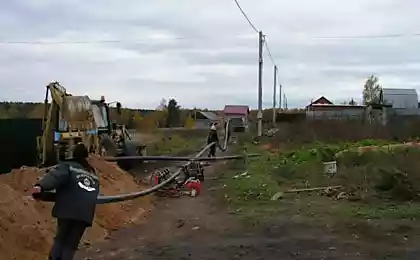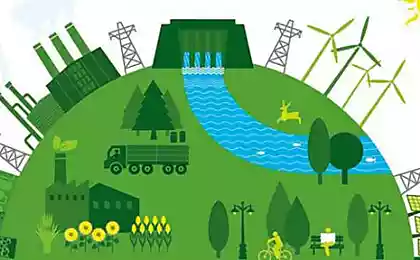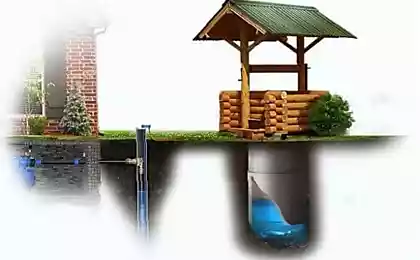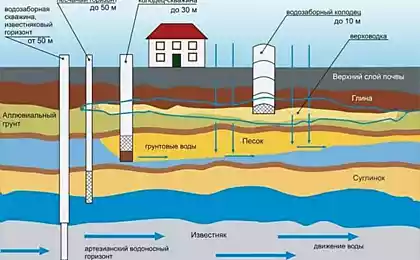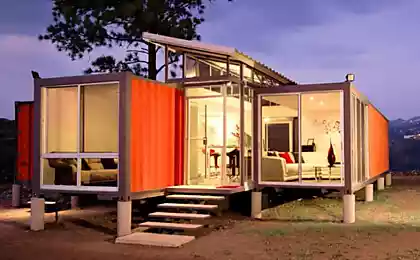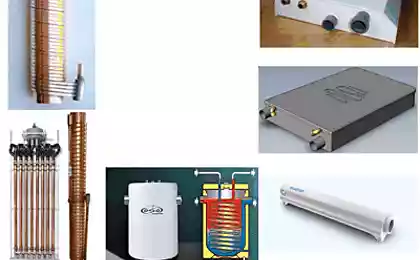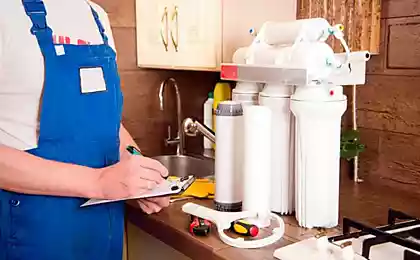226
Saving at home: how to give up hot water
Why you should give up the city GVSThe urban system of the GVS is known to many for its poor quality of services. The use of it not only often costs a penny, in many apartments the water is supplied underheated to the established norms and its temperature above 40-50 ° C practically does not rise. To this should be added a few weeks of lack of hot water during the summer scheduled shutdowns, when owners are forced to heat water for household and sanitary needs literally improvised methods.
The alternative is to refuse to supply hot water to the apartment and heat it yourself using an electric or gas water heater. At the same time, interventions in rough plumbing are minimal, most devices have a simple binding scheme and can be installed even after finishing works are completed.
What needs to be done:
1. Contact ESO or utilities with a request to disconnect from the city GVS system. If it is possible for the project of the house, get the technical conditions.
2. Install a water heater and tie it.
3. Provide for the installation of seals at each outlet of each of the risers of the GWS. The best option is stubs with hinges for sealing.
4. In the presence of the inspector, draw up an act of disconnection and the presence of a visible rupture of the pipeline.
Why is this considered a savings?The benefit of switching to hot water self-sufficiency seems obvious when you consider that the cost of one cubic meter is the total heat loss throughout the system. For example, consider a special case for a small apartment in the Moscow region. As of July 2015, tariffs for utilities in the region are as follows:
Type of service Tariff, RUB GVS, m3 120.82 HVS, m3 30.87 Stocks 21.9 Electricity at single rate, kW 5.03 Electricity in three zones, kW for 1/2/3 zones 5.58/4.63/1.43 Natural gas, m3 6.04
A family of four people consumes an average of 16 m3 of hot water per month, that is, they pay for the city’s hot water supply of 1933.12 rubles per month. The cost of the water in the tariff GVS is 493.92 rubles, the remaining 1,439.20 rubles. is the cost of heating 16 m3 of water to 50 ° C, that is, 89 rubles. 95 kopecks for 1 m3.
As you can see, water heating plants in the urban system are not very economical, because 17.9 kW of electricity is spent on heating one cubic meter at a single rate or 14.9 m3 of natural gas.
Payback periodBut will household appliances be economical enough to pay for themselves in the foreseeable future? For the family of 4 people mentioned above, about 500 liters of hot water per day are needed. This task can be achieved by a pressure flow water heater with a capacity of 6-6.5 kW or a storage heater with a buffer capacity and a total power of TENs up to 3 kW.
A good and reliable storage heater will cost about 10,000–20,000 rubles, and flowing – 15,000–30,000 rubles. Flow-through will be somewhat more difficult to install, since everything that has an electrical power above 3 kW must be connected by a separate cable with a cross-section of veins from 4 mm2 with the mandatory organization of protective grounding and disconnection, and this is an additional 3500 rubles. For the boiler, you need only a differential machine costing 1400 rubles. and an ordinary socket on a separate protective group.
As for plumbing, it is the same for both devices. Since the water heater can be cut into almost any point of hot and cold water pipes, to connect it you will need a set of valves and 6-8 meters of pipe, which will cost another 3000 rubles. In total, the cost of flowing water heater and its installation will amount to 35,500 rubles, and the cumulative will pull 30,400 rubles.
Example of connecting a storage water heater: 1 - a valve of incoming cold water; 2 - a safety valve; 3 - a drain valve; 4 - valve for air when draining water; 5 - storage water heater; 6 - differential automatic; 7 - to the shield; 8 - water to consumers
A storage water heater of 120 liters with a capacity of 2 kW takes 2 hours to heat water to 50 degrees. To heat 1 m3 it will need 1000 / 120 x 2 x 2 = 33.33 kWh. That is, for self-sufficiency, it is necessary that the average cost of electricity for the water heater is less than 2.70 rubles.
A flow heater with a throughput of 3 l / min per hour will heat 180 liters of water, spending 8 kWh on this. That is, its electricity consumption is higher by about 30%. It can be argued that the storage water heater consumes energy not only for direct heating, but also for maintaining the temperature, but these are short-term inclusions and such an amendment can be neglected.
In fact, only gas water heaters are economical in this respect, and they are cheaper than electric ones. With a power of 24 kW and a duct of 14 l / min, the column will warm up a cubic meter of water to 70-80 ° C in about 70 minutes, spending less than three cubic meters of gas.
Which water heater to choose?If in the project of an apartment there is an opportunity to install a gas heater - this is exactly what you need to do. Even half a thousand rubles a month for GVS is not money, while water is stable, under good pressure and in full. No electric heater can do that.
If the house is not gasified, which in modern construction happens more and more often, the use of electric water heaters cannot be avoided. Yes, there is a slight overpayment, but how much more comfortable life becomes! Especially since you can not spend money on an expensive heater, but install a cheaper one.
The highest water consumption is observed in the evening and at night, when the electricity tariff is 4.63 and 1.43 rubles. for 1 kW. The average daily cost of a kilowatt for the work of the GVS is about 1.8 rubles. And at this cost, the price of electric hot water is quite comparable to the city. At the very least, hot water is not more expensive, and the whole system is reliable and durable. The most economical in this case, large storage water heaters connected through a contactor with a timer to work only in the night and semi-peak daily zones. Their payback period is usually about 3 years, flowing will pay off in 5-7 years. If the water is supplied to the house underheated, then the payback period will be significantly reduced, because the consumption of hot water will be significantly reduced.
Tips for placing a water heater
Heaters, with the exception of pressure-free flow, are prohibited to be placed in the bathroom according to electrical safety requirements. Therefore, the best place to place storage water heaters is a toilet, and for pressure flowing ones - a kitchen or a niche kitchen set.
In both places there is a supply of both cold and hot water, even tees can be easily cut into the pipes at the connection point of the kitchen sink. Do not forget that the storage water heater must be supplied with a reverse valve, and the flow valve with a mesh filter. published
P.S. And remember, just changing our consumption – together we change the world!
Join us on Facebook, VKontakte, Odnoklassniki
Source: www.rmnt.ru/story/water/1019857.htm
The alternative is to refuse to supply hot water to the apartment and heat it yourself using an electric or gas water heater. At the same time, interventions in rough plumbing are minimal, most devices have a simple binding scheme and can be installed even after finishing works are completed.
What needs to be done:
1. Contact ESO or utilities with a request to disconnect from the city GVS system. If it is possible for the project of the house, get the technical conditions.
2. Install a water heater and tie it.
3. Provide for the installation of seals at each outlet of each of the risers of the GWS. The best option is stubs with hinges for sealing.
4. In the presence of the inspector, draw up an act of disconnection and the presence of a visible rupture of the pipeline.
Why is this considered a savings?The benefit of switching to hot water self-sufficiency seems obvious when you consider that the cost of one cubic meter is the total heat loss throughout the system. For example, consider a special case for a small apartment in the Moscow region. As of July 2015, tariffs for utilities in the region are as follows:
Type of service Tariff, RUB GVS, m3 120.82 HVS, m3 30.87 Stocks 21.9 Electricity at single rate, kW 5.03 Electricity in three zones, kW for 1/2/3 zones 5.58/4.63/1.43 Natural gas, m3 6.04
A family of four people consumes an average of 16 m3 of hot water per month, that is, they pay for the city’s hot water supply of 1933.12 rubles per month. The cost of the water in the tariff GVS is 493.92 rubles, the remaining 1,439.20 rubles. is the cost of heating 16 m3 of water to 50 ° C, that is, 89 rubles. 95 kopecks for 1 m3.
As you can see, water heating plants in the urban system are not very economical, because 17.9 kW of electricity is spent on heating one cubic meter at a single rate or 14.9 m3 of natural gas.
Payback periodBut will household appliances be economical enough to pay for themselves in the foreseeable future? For the family of 4 people mentioned above, about 500 liters of hot water per day are needed. This task can be achieved by a pressure flow water heater with a capacity of 6-6.5 kW or a storage heater with a buffer capacity and a total power of TENs up to 3 kW.
A good and reliable storage heater will cost about 10,000–20,000 rubles, and flowing – 15,000–30,000 rubles. Flow-through will be somewhat more difficult to install, since everything that has an electrical power above 3 kW must be connected by a separate cable with a cross-section of veins from 4 mm2 with the mandatory organization of protective grounding and disconnection, and this is an additional 3500 rubles. For the boiler, you need only a differential machine costing 1400 rubles. and an ordinary socket on a separate protective group.
As for plumbing, it is the same for both devices. Since the water heater can be cut into almost any point of hot and cold water pipes, to connect it you will need a set of valves and 6-8 meters of pipe, which will cost another 3000 rubles. In total, the cost of flowing water heater and its installation will amount to 35,500 rubles, and the cumulative will pull 30,400 rubles.
Example of connecting a storage water heater: 1 - a valve of incoming cold water; 2 - a safety valve; 3 - a drain valve; 4 - valve for air when draining water; 5 - storage water heater; 6 - differential automatic; 7 - to the shield; 8 - water to consumers
A storage water heater of 120 liters with a capacity of 2 kW takes 2 hours to heat water to 50 degrees. To heat 1 m3 it will need 1000 / 120 x 2 x 2 = 33.33 kWh. That is, for self-sufficiency, it is necessary that the average cost of electricity for the water heater is less than 2.70 rubles.
A flow heater with a throughput of 3 l / min per hour will heat 180 liters of water, spending 8 kWh on this. That is, its electricity consumption is higher by about 30%. It can be argued that the storage water heater consumes energy not only for direct heating, but also for maintaining the temperature, but these are short-term inclusions and such an amendment can be neglected.
In fact, only gas water heaters are economical in this respect, and they are cheaper than electric ones. With a power of 24 kW and a duct of 14 l / min, the column will warm up a cubic meter of water to 70-80 ° C in about 70 minutes, spending less than three cubic meters of gas.
Which water heater to choose?If in the project of an apartment there is an opportunity to install a gas heater - this is exactly what you need to do. Even half a thousand rubles a month for GVS is not money, while water is stable, under good pressure and in full. No electric heater can do that.
If the house is not gasified, which in modern construction happens more and more often, the use of electric water heaters cannot be avoided. Yes, there is a slight overpayment, but how much more comfortable life becomes! Especially since you can not spend money on an expensive heater, but install a cheaper one.
The highest water consumption is observed in the evening and at night, when the electricity tariff is 4.63 and 1.43 rubles. for 1 kW. The average daily cost of a kilowatt for the work of the GVS is about 1.8 rubles. And at this cost, the price of electric hot water is quite comparable to the city. At the very least, hot water is not more expensive, and the whole system is reliable and durable. The most economical in this case, large storage water heaters connected through a contactor with a timer to work only in the night and semi-peak daily zones. Their payback period is usually about 3 years, flowing will pay off in 5-7 years. If the water is supplied to the house underheated, then the payback period will be significantly reduced, because the consumption of hot water will be significantly reduced.
Tips for placing a water heater
Heaters, with the exception of pressure-free flow, are prohibited to be placed in the bathroom according to electrical safety requirements. Therefore, the best place to place storage water heaters is a toilet, and for pressure flowing ones - a kitchen or a niche kitchen set.
In both places there is a supply of both cold and hot water, even tees can be easily cut into the pipes at the connection point of the kitchen sink. Do not forget that the storage water heater must be supplied with a reverse valve, and the flow valve with a mesh filter. published
P.S. And remember, just changing our consumption – together we change the world!
Join us on Facebook, VKontakte, Odnoklassniki
Source: www.rmnt.ru/story/water/1019857.htm
How we all survived!? Children 50-60-70-80-ies dedicated!!!
Looked like young people who are making world politics
